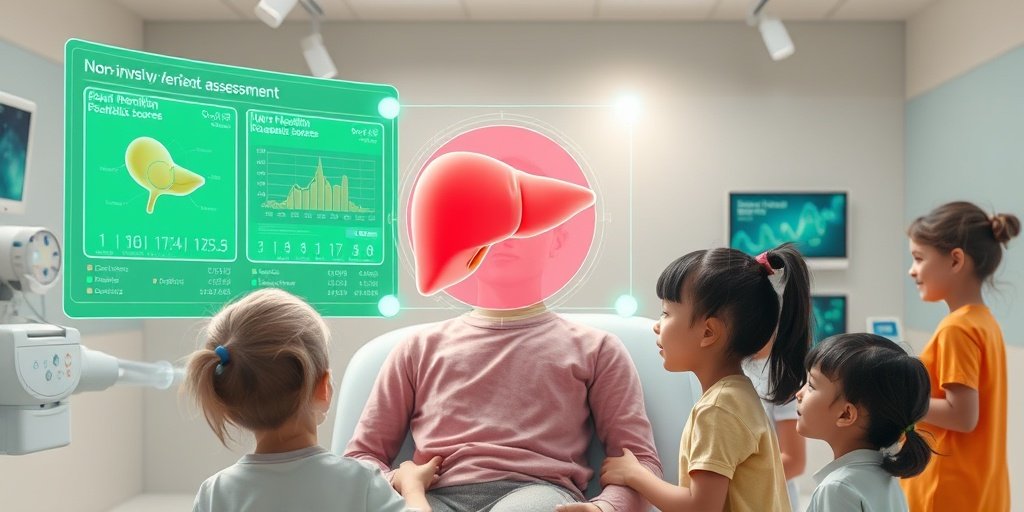⚡ Quick Summary
A recent study introduced a machine-learning fibrosis score for pediatric metabolic dysfunction-associated steatotic liver disease (MASLD), achieving an impressive AUROC of 0.92. However, experts caution that this promising tool may be premature and requires further validation.
🔍 Key Details
- 📊 Study Focus: Machine-learning fibrosis score for pediatric MASLD
- 🧩 Key Metric: AUROC of 0.92 for advanced fibrosis detection
- ⚙️ Concerns: Overfitting, ethnic variability, and unproven clinical utility
- 🌍 Population Studied: Mono-ethnic Chinese cohort
🔑 Key Takeaways
- 📈 MASLD is now the leading cause of chronic liver disease in children, affecting up to 38% of obese children.
- 💡 The new CH-MASLD-Fib score shows high accuracy but may not generalize well across diverse populations.
- ⚠️ Established pediatric fibrosis scores perform modestly, with AUROC values around 0.6-0.7.
- 🔍 Ethnic differences in MASLD prevalence raise concerns about the applicability of the model.
- 💰 Clinical utility and cost-effectiveness of the CH-MASLD-Fib score remain unproven.
- 🧪 Dependence on specialized assays could limit access and increase costs for patients.
- 🔄 External validation in multi-ethnic cohorts is recommended before clinical implementation.
- 🩺 Clinical judgment should remain anchored in readily available markers and targeted liver biopsy.

📚 Background
Metabolic dysfunction-associated steatotic liver disease (MASLD) has emerged as a significant health concern among children, particularly those with obesity. The shift from non-alcoholic fatty liver disease (NAFLD) to MASLD highlights the need for effective diagnostic tools. As the prevalence of MASLD rises, the development of non-invasive fibrosis assessment tools becomes increasingly critical.
🗒️ Study
The study conducted by Yao et al. aimed to develop a machine-learning score, termed CH-MASLD-Fib, to assess advanced fibrosis in pediatric patients with MASLD. Utilizing a single-center cohort, the researchers reported a high AUROC of 0.92, indicating strong potential for this new diagnostic tool.
📈 Results
While the CH-MASLD-Fib score demonstrated a remarkable AUROC of 0.92, experts caution that this result may reflect overfitting due to the study’s reliance on a single-center cohort. In contrast, established pediatric fibrosis scores have shown modest performance, with AUROC values ranging from approximately 0.6 to 0.7, raising questions about the robustness of the new model.
🌍 Impact and Implications
The introduction of the CH-MASLD-Fib score could significantly impact the diagnosis and management of MASLD in children. However, the concerns regarding its generalizability and clinical utility underscore the need for further research. Until external validation is achieved, healthcare providers should continue to rely on established methods and clinical judgment for assessing liver health in pediatric patients.
🔮 Conclusion
The study presents a promising advancement in the use of machine learning for assessing fibrosis in pediatric MASLD. However, the potential for overfitting and the need for validation in diverse populations highlight the importance of cautious optimism. Continued research and validation are essential to ensure that such tools can be effectively integrated into clinical practice, ultimately improving patient outcomes.
💬 Your comments
What are your thoughts on the use of machine learning in diagnosing pediatric liver diseases? We invite you to share your insights and engage in the discussion! 💬 Leave your comments below or connect with us on social media:
Machine learning fibrosis score for pediatric metabolic dysfunction-associated steatotic liver disease: Promising but premature.
Abstract
Metabolic dysfunction-associated steatotic liver disease (MASLD) is now the leading cause of chronic liver disease in children, affecting up to 38% with obesity of children. With the global shift from non-alcoholic fatty liver disease (NAFLD) to MASLD using affirmative criteria (hepatic steatosis plus ≥ 1 cardiometabolic risk factor) and approximately 99% concordance in pediatrics, the development of non-invasive fibrosis tools is accelerating. Yao et al report a machine-learning “chronic MASLD with fibrosis (CH-MASLD-Fib)” score for advanced fibrosis with area under the receiver operating characteristic curve (AUROC) of 0.92. While timely, we urge caution. First, high accuracy from a single-center cohort signals overfitting: Complex models can learn cohort-specific noise and fail to generalize. Consistent with this, established pediatric scores (NAFLD fibrosis score, fibrosis-4, pediatric NAFLD fibrosis score) perform modestly (AUROC: Approximately 0.6-0.7), and aspartate aminotransferase-to-platelet ratio index is variable, raising concern that CH-MASLD-Fib’s result reflects a statistical artifact. Second, MASLD epidemiology varies by ethnicity (highest in Hispanic, lower in Black children); a model derived in a mono-ethnic Chinese cohort may misclassify other populations. Third, clinical utility and cost-effectiveness are unproven; dependence on specialized assays (e.g., bile acids, cholinesterase) would limit access and increase cost. We recommend external validation in multi-ethnic cohorts, head-to-head comparisons with simple serum indices and elastography, and formal economic analyses. Until then, clinical judgment anchored in readily available markers and judicious, targeted liver biopsy remains paramount.
Author: [‘Yodoshi T’]
Journal: World J Gastroenterol
Citation: Yodoshi T. Machine learning fibrosis score for pediatric metabolic dysfunction-associated steatotic liver disease: Promising but premature. Machine learning fibrosis score for pediatric metabolic dysfunction-associated steatotic liver disease: Promising but premature. 2025; 31:112217. doi: 10.3748/wjg.v31.i36.112217